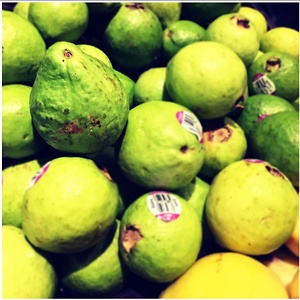


Brazilian Gold Guavas
Estimated Inventory, lb : 0
This item was last sold on : 12/29/24
Description/Taste
Brazilian guavas are small fruits, averaging 1 to 3 centimeters in diameter, and have a round to oval shape. The skin is smooth and thin, easily damaged and often showing brown markings, and ripens from light green to golden yellow. As the fruit matures, the firm surface will also soften, giving slightly when pressure is applied. Underneath the skin, the white to yellow flesh is dense, soft, aqueous, semi-grainy, and creamy, similar in consistency to a banana. The flesh also encases many small, edible but hard, cream-colored seeds and emits a pungent, floral and fruity aroma. Brazilian guavas have a subacid to mildly acidic nature, bearing a sweet, tropical flavor with notes of pineapple, papaya, strawberries, and banana.
Seasons/Availability
Brazilian guavas are available year-round in tropical climates and in the late winter through early spring in subtropical climates.
Current Facts
Brazilian guavas, botanically classified as Psidium guineense, are tropical fruits that grow on a small shrub or tree reaching up to 7 meters in height, belonging to the Myrtaceae family. The guava relative is found in tropical to subtropical climates worldwide and is a lesser-known Psidium species compared to common guava, Psidium guajava. Brazilian guavas are not true guavas and received the guava misnomer from their close resemblance and similar flavor to common guava varieties. The aromatic fruits are also known as Araca in Brazil, Castilian guava in California, Guayaba Brava in Peru, Goiaba in Portuguese, and Guayaba Agria in Mexico, and the variety is favored for its fruity flavor in fresh and cooked applications.
Nutritional Value
Brazilian guavas are an excellent source of vitamin C to boost the immune system and calcium to strengthen bones and teeth. The fruits are also a good source of potassium to balance fluid levels within the body, vitamin A to promote optimal organ functioning, fiber to stimulate the digestive tract, and lower amounts of iron, phosphorus, and folates.
Applications
Brazilian guavas have soft, aromatic flesh well-suited for fresh and cooked applications such as simmering, stewing, and baking. The skin, flesh, and seeds are all edible, but it is important to note that the seeds are very hard and can crack teeth if chewed. Brazilian guavas can be sliced in half and consumed straight, out-of-hand, blended into juices and smoothies, or sliced and tossed into green salads and fruit bowls. In addition to raw preparations, Brazilian guavas contain pectin and can be cooked into jams, jellies, pastes, and preserves. The aromatic pastes can also be used as filling in cakes, tarts, pies, and other baked goods. Brazilian guavas pair well with other fruits, including coconut, apples, strawberry, oranges, and pineapple, vanilla, honey, nuts such as hazelnuts, cashews, and macadamia, and meats such as poultry, beef, and pork. Whole, unwashed Brazilian guavas will ripen at room temperature, and once mature, they can be kept for an additional 2 to 4 days in the refrigerator.
Ethnic/Cultural Info
Brazilian guavas are a favored variety for processing into goiabada, a thick paste-like dessert commonly prepared and consumed in Brazilian homes. Goiabada is traditionally made with red guavas giving the paste a pink to red hue, but Brazilian guavas are a popular alternative variety contributing different flavors to the dessert. The paste is made from guavas, water, and sugar and was created in 16th century Brazil as a substitute for quince paste. One of the most popular preparations using goiabada is Romeo and Juliet, which consists of guava paste layered with a dense cheese called gueijo minas. The salty, neutral flavor of the cheese complements the sweet, tropical, and fruity taste of the paste, creating a balanced, bite-sized dish. Goiabada can also be spread on toast, incorporated into dessert pizzas, used as filling in baked goods, or mixed into barbeque sauce to create a salty, sweet, and smoky flavor.
Geography/History
Fruits of the Psidium genus are native to tropical and subtropical regions of the Western Hemisphere, spanning from Mexico into Central and South America and also found in parts of the Caribbean. Since ancient times, species found within the Psidium genus were quickly spread to warm growing regions worldwide through migrating peoples, trade, and bird’s dropping the seeds through excrement. Many of these species naturalized in the new areas and became extensively cultivated, adding to the genetic diversity. Brazilian guavas are believed to have been developed in Brazil from unknown naturalized wild species. Today Brazilian guavas are found through local markets and home gardens in Brazil, other regions of South America, Jamaica, Cuba, Martinique, Trinidad, Guadeloupe, the Dominican Republic, Indonesia, Northeastern India, French Polynesia, Australia, and South Africa. The fruits are also grown on a small scale in California and are sold through specialty grocers and farmer’s markets.
Recipe Ideas
Recipes that include Brazilian Gold Guavas. One
| Cultural Chromatics |
|
Vanilla Poached Guava Coconut Panna Cotta |
| The 350 Degree Oven |
|
Homemade Fresh Guava Jam |
| From Brazil To You |
|
Guava-Lemon Mousse (Mousse de Goiaba e Limão) |















